Term archive
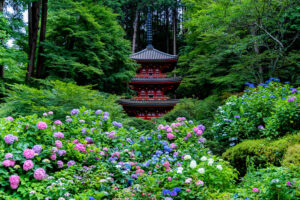
投稿タイプ:sightseeing
Gansenji Temple
Gansenji Temple is an ancient Buddhist temple in Kamo-cho, Kizugawa City, the southernmost part of Kyoto Prefecture. It’s located in the tea-producing region of Kyoto. The temple was founded in 729. The name "Gansenji" translates literally to "Rock Boat Temple," and near the entrance of the temple is a boat-shaped rock, where legend has it that monks used it for sacred cleansing rituals. In the temple precincts, the Three-storied Pagoda, the Important Cultural Property, stands surrounded by nature. It looks dignified and mystic, and its wooden demon carvings are very interesting. The temple is famous for its hydrangeas that are beautiful around June. After the hydrangeas, water lilies and crape myrtle blossoms follow, and fall foliage is impressive as well. In the cold season, you can see vivid camellia flowers and pretty plum blossoms, and in the spring, cherry blossoms are amazing. The temple is also adorned by a variety of other flowers, and is truly a sight to see in any of the four seasons. Gansenji Temple’s wooden statue of Seated Amida Nyorai is about three meters tall, and the gentle, sublime expression brings comfort to viewers. You’ll be overwhelmed as you imagine the original appearance from the whole statue’s golden glow and the faint vermilion paint remaining on the clothes even after a thousand years. The serene aura of the enlightened Amida Nyorai is captivating, and there is another awesome statue, Fugen (Samantabhadra) Bodhisattva riding a white elephant. This statue was restored in December 2024 for the first time in 113 years. As a side note, paths connecting Gansenji Temple and Joruriji Temple called Sekibutsu no Michi (paths with stone Buddhas) are a great place for hiking through history where you can meet many stone Buddhas.
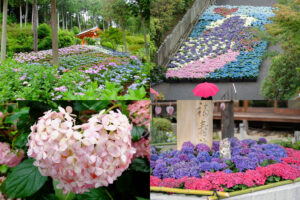
投稿タイプ:sightseeing
Mimurotoji
The Mimurotoji temple is located in Uji City in the Kyoto Tea Country region, southern Kyoto Prefecture. This temple has a long history, and its Treasure House enshrines Buddhist statues including Important Cultural Properties. It is also known for its magnificent gardens. Referred to as Hana no Tera (the flower temple), it is among the most renowned flower spots in the Kansai region. Strolling the garden paths during the blooming seasons allows visitors to be surrounded by a profusion of flowers. Around late February to March, weeping plums bloom on an elevated area, offering a lovely view together with the landscape of the city. Around April, 10,000 azaleas, including red ones, come into bloom. Additionally, around late April to early May, the other azalea garden showcases approximately 20,000 flowers in white and pink hues. Around June, about 20,000 hydrangea plants of various colors, such as blue, purple, pink, and white, can be enjoyed. Around late June to early August, lotus flowers (which bloom in the morning) can be seen in front of the main hall. Their gradation of colors, primarily white and pink, is very beautiful. The temple offers various other flowers and autumn foliage. Also, there is a pond and a dry rock garden where you can feel the beauty of Japan. Depending on the season, there may be a teahouse in the precincts. It would be nice to take a break there while enjoying the beautiful flowers.
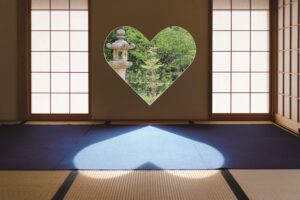
投稿タイプ:sightseeing
Shoujuin
Shoujuin, a Buddhist temple of the Koyasan Shingon sect, is located in Ujitawara Town in southern Kyoto. It was founded in 1200, more than 800 years ago. Two fires between the 15th and 19th centuries limited the records of this temple, but it is known that a monk Yuin revived it in 1596.
The temple's principal image, the eleven-headed Kanzeon (Avalokiteśvara) Bodhisattva statue, is designated as a cultural property of Ujitawara Town. The statue is unveiled only once every 50 years. (It is being held as of April 2025!) There is also a seated statue of Fudo Myo-o (Acala), one of the Buddhist Wisdom Kings. It is the work of Kaikei, one of the representative Buddhist statue sculptors of the Kamakura Period (1185-1333) in Japan. This statue is an Important Cultural Property of Japan.
The temple holds its annual festival featuring fūrin (wind chimes) from June 1st to September 30th. Over 2,000 wind chimes create a cool and pleasant atmosphere with the visual and auditory beauty.
In the guest hall, there is Inome-mado (boar’s eye window), which is always attracting many visitors. The Inome (boar’s eye), a heart-shaped motif, is a traditional design that has been used since approximately 1400 years ago, primarily for architectural adornment in shrines and temples. The Inome has been believed to ward off evil spirits and bring good fortune. Shoujuin’s Inome-mado offers beautiful sights of the garden that transform with the seasons: pink cherry blossoms in spring, lush greenery in summer, colored leaves in fall, and a white snowscape in winter. Moreover, if the season and time are just right, you might encounter a miraculous moment when the sunlight streams through the window, creating another heart shape in the shadow. This sight is called Shiawase no Okage, which means a blessing of happiness. (Awase means something put together, and kage means shadow in Japanese.)
Also, the 160 different paintings on the ceiling of the guest hall are eye-catching. These artworks mainly depict seasonal flowers, plants and landscapes of Japan. Among them, you can find beautiful maiko (young female apprentices learning various traditional Japanese performing arts), too.
In addition, this temple offers great experiences, such as juzu (a bracelet of prayer beads) creating, shakyo (sutra copying), shabutsu (Buddha copying), and yoga. (Reservations required.)
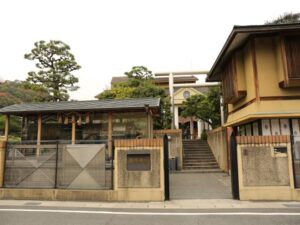
投稿タイプ:sightseeing
Hiko-jinja Shrine
Hiko-jinja Shrine, located in Yawata City, was founded in 1915 by a pioneer of aviation, Chuhachi Ninomiya. He achieved Japan’s first successful flight of a rubber-powered, crow-type model aircraft. “Hiko” of “Hiko-jinja Shrine” means “flight” in Japanese.
The shrine is dedicated to Nigihayahi-no-Mikoto, known as an ancient deity of the sky, victims of aviation accidents, great people who made significant contributions to the aviation industry, and more. For this reason, various people from home and abroad visit it to pray for safety in flight, successful development and invention, academic successes and passing exams, or other related blessings.
Hiko-jinja Shrine looks very different from other traditional shrines, with its architectural style reminiscent of ancient Greek buildings, and metal torii (a gate most commonly found at a Shinto shrine in Japan). You can also find a great metal propeller on display, and a cluster of small airplanes floating in a washbasin that visitors use to wash and purify their hands.
As the shrine was built on the site of Chuhachi Ninomiya's residence, a wealth of materials related to his researches and experiments are preserved here. They are displayed with donated things by various people. (A fee is required for admission to the museum.)
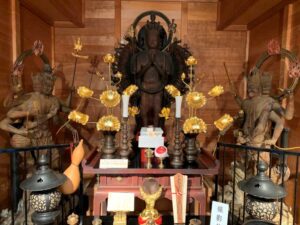
投稿タイプ:sightseeing
Juhoji Temple
Juhoji Temple, located in Kyotanabe City, is thought to have been established in 704.
The main hall enshrines the standing statue of the temple's principal deity, the Thousand-Armed Kannon. It is a 180 cm tall wooden statue, a masterpiece designated as an Important Cultural Property. Along with the statues of Fujii-dera Temple in Osaka and Toshodaiji Temple in Nara, this statue is one of the three Thousand-Armed Kannon statues in Japan that actually have one thousand hands. On each of its hands is a charcoal drawn eye, most of which have faded with time, but some still remain. Another unique feature of the statue is how the face expressions change with the light. In the brightness of daytime, it appears solemn and dignified, while bathed in the soft lighting, such as that seen at dusk, it seems much softer and gentler. It has a mysterious fascination that captivates viewers.
Advance reservations are required to see the Thousand-Armed Kannon statue (phone: 0774-65-3422). Please provide the date of your visit and number of visitors. (Viewing is unavailable on rainy or humid days as a general rule.) You can hear explanations of the statue, so consider bringing a translation device or going with someone who understands Japanese to fully enjoy your visit.
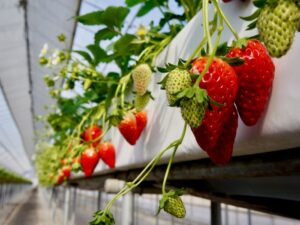
投稿タイプ:sightseeing
Hanayagi Strawberry Farm
This fun place opened in 2003 in Seika Town, southern Kyoto Prefecture. They offer strawberry picking and edamame (young soybean) harvesting.
From winter to around spring, you can pick and enjoy the flavor of your own strawberries, freshly picked, sweet and juicy. (The exact timing varies from year to year.) You can eat as many strawberries as you like for 40 minutes. The main variety is the popular Akihime, with occasional Benihoppe. The bright red strawberries grow in abundance, which is a feast for the eye, too. They use raised beds, and there is no need to bend over low, and the aisles are wide. It’s a comfortable place offering an exciting experience for anyone, including people with strollers and wheelchairs. Furthermore, their greenhouses can accommodate large groups. Even groups of 200-300 people have enjoyed it. Groups can come by bus, too. In addition, the farm offers products using their strawberries, as well as freshly packed strawberries.
The edamame harvesting is held in October. You can harvest high-quality black soybeans Shin-tamba-guro, one of the local specialties of the Tamba region in Kyoto. They are also available for purchase at the farm's direct sales store. Both strawberry and edamame harvesting require advance reservations by phone or through their website.
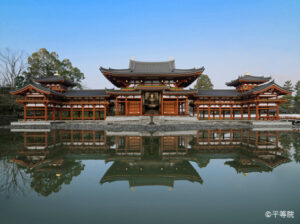
投稿タイプ:sightseeing
Byodoin Temple
Byodoin Temple, located on the west bank of the Uji River, shows the historical glory of the Fujiwara clan's prosperity. Originally Minamoto no Toru’s villa, it was later acquired by Fujiwara no Michinaga, and his son Yorimichi converted it into the temple in 1052. The Phoenix Hall (Hou-ou-do), which is a National Treasure, appears to float on the Aji-ike Pond. The pond extending in front of the building is a characteristic example of Heian Period (794-1185) gardens. However, the Phoenix Hall and its surrounding garden together represent something far more profound. It is the Heian aristocrats' aspiration to be reborn in Gokuraku Jodo (the Pure Land in Buddhism). The belief that such a beautiful world awaited them held great significance for them. The Phoenix Hall enshrines Amida Buddha (Amida Nyorai). The hall is a familiar sight in Japan, being depicted on the 10 yen coin.
At the Byodoin Temple Museum “Hoshokan,” a collection of precious artifacts owned by the temple is on display. It includes valuable National Treasures: a pair of Phoenix, 26 Statues of the Praying Bodhisattva (Buddhist Saint) on Clouds, and 1 Temple Bell. Also, the museum offers restored footage generated through computer graphics utilizing state-of-the-art digital technology.
